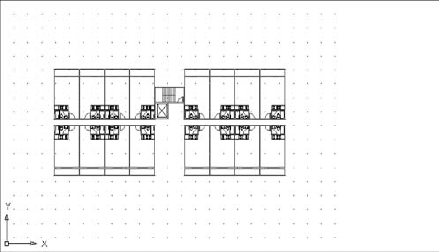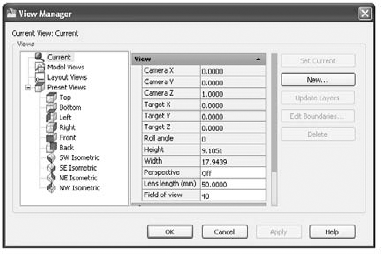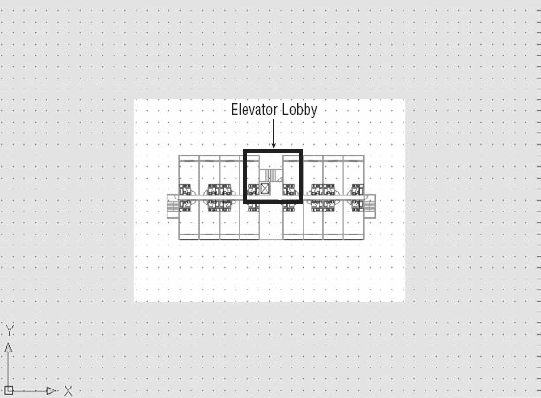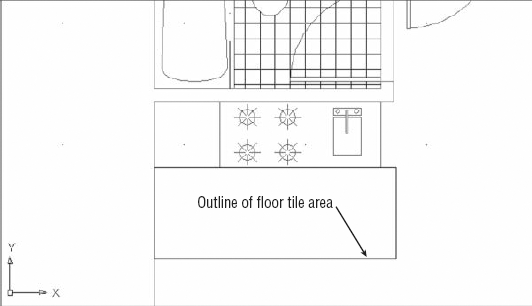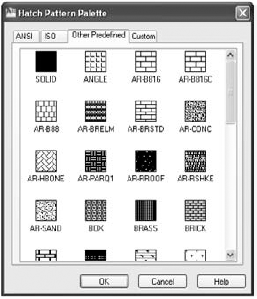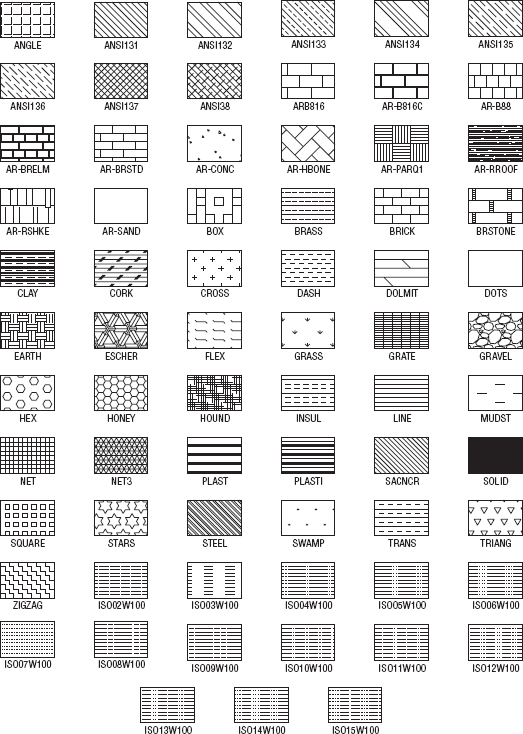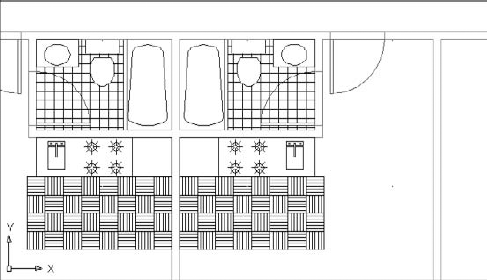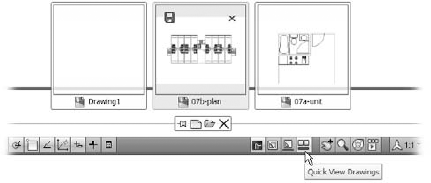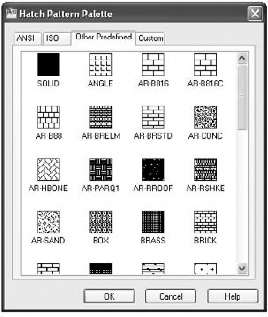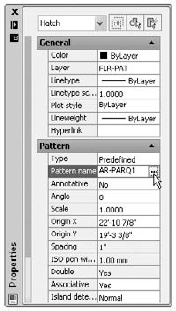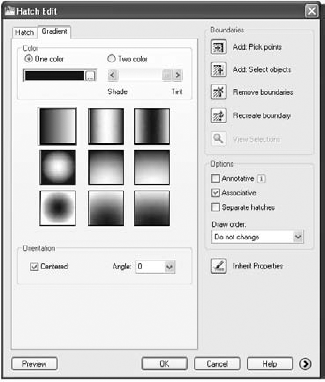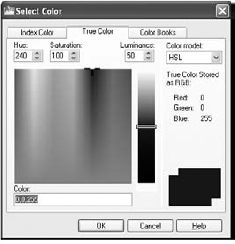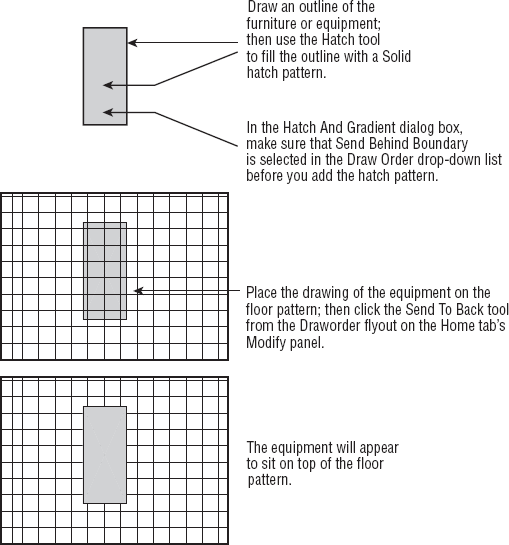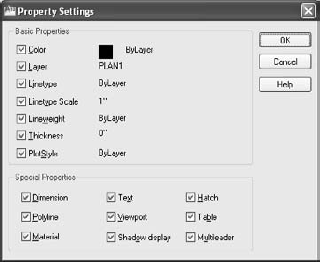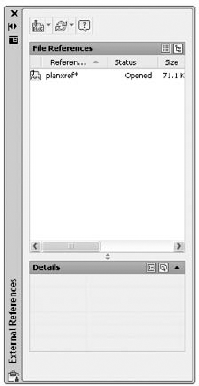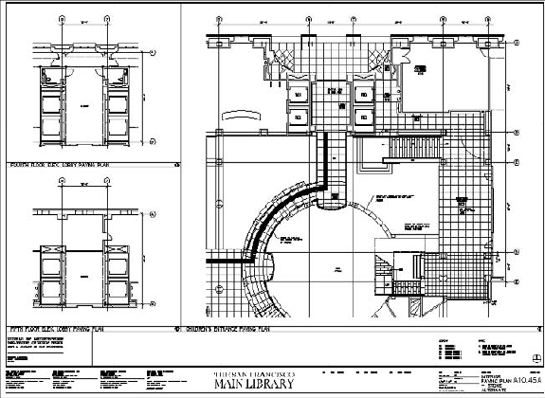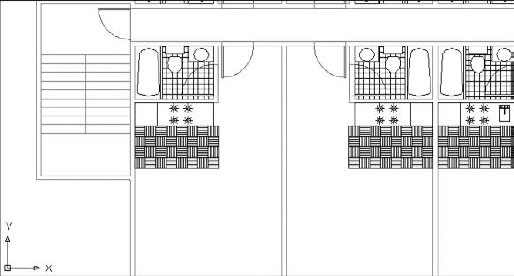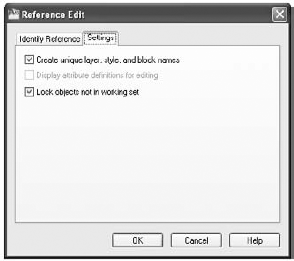Now that you've created drawings of a typical apartment unit and the apartment building's lobby and stairs, you can assemble them to complete the first floor of the apartment building. In this chapter, you'll take full advantage of AutoCAD's features to enhance your drawing skills as well as to reduce the time it takes to create accurate drawings.
As your drawing becomes larger, you'll find that you need to use the Zoom and Pan commands more often. Larger drawings also require some special editing techniques. You'll learn how to assemble and view drawings in ways that will save you time and effort as your design progresses. Along the way, you'll see how you can enhance the appearance of your drawings by adding hatch patterns.
In this chapter, you'll learn to do the following:
One of the best timesaving features of AutoCAD is its ability to duplicate repetitive elements quickly in a drawing. In this section, you'll assemble the drawings you've been working on into the complete floor plan of a fictitious apartment project. This will demonstrate how you can quickly and accurately copy your existing drawings in a variety of ways.
Start by creating a new file for the first floor:
Create a new file named
Planto contain the drawing of the apartment building's first floor. This is the file you'll use to assemble the unit plans into an apartment building. If you want to use a template file, useAcad.dwt. Metric users can use theAcadiso.dwttemplate file. (These are AutoCAD template files that appear in the Create New Drawing dialog box when you choose New from the Quick Access toolbar.)
Set up the drawing for a ⅛″ = 1′-0″ scale on a 24″-× −18″ drawing area (choose Drawing

Create a layer called Plan1, and make it the current layer.

Set Snap Spacing to 1, and set Grid Spacing to 8′, which is the distance required to display 1″ divisions in a ⅛″ = 1′-0″ scale drawing. Metric users can set the Grid mode to 250.


Now you're ready to start building a floor plan of the first floor from the Unit plan you created in the previous chapter. You'll start by creating a mirrored copy of the apartment plan:
If you prefer, you can specify the insertion point in the Insert dialog box by removing the check mark from the Specify On-Screen check box. The Input options in the dialog box then become available to receive your input.
Zoom in to the apartment unit plan.

At the
Specify first point of the mirror line:prompt, Shift+right-click the mouse, and choose From.Shift+right-click again, and choose Endpoint.
Select the endpoint of the upper-right corner of the apartment unit, as shown in Figure 7.1.
Enter @2.5<0


At the
Erase Source Objects? [Yes/No] :prompt, press
You now have a mirror-image copy of the original plan in the exact location required for the overall plan. Next, make some additional copies for the opposite side of the building:
Press

Use the From osnap option again, and using the Endpoint osnap, select the same corner you selected in step 6 of the preceding set of steps.
Enter @24<90 to start a mirror axis 24″ directly above the selected point. Metric users should enter @61<90.

At the
Erase source objects? [Yes/No] :prompt, press
With the tools you've learned about so far, you've quickly and accurately set up a fairly good portion of the floor plan. Continue with the next few steps to "rough in" the main components of the floor:
If you happen to insert a block in the wrong coordinate location, you can use the Properties palette to change the insertion point for the block.
Copy the four units to the right at a distance of 28′-10″ (878 cm for metric users), which is the width of two units from center line to center line of the walls.
Insert the lobby at coordinate 89′-1″,76′-1″ (2713,2318 for metric users).
Copy all the unit plans to the right 74′-5″ (2267 cm for metric users), the width of four units plus the width of the lobby.

Click Save on the Quick Access toolbar to save this
Plan.dwgfile to disk.
By now, you should be familiar with the Pan and Zoom functions in AutoCAD. Many other tools can also help you get around in your drawing. In the following sections, you'll get a closer look at the ways you can view your drawing.
AutoCAD uses two commands for refreshing your drawing display: drawing regeneration (Regen) and Redraw. Each command serves a particular purpose, although it may not be clear to a new user.
To better understand the difference between Regen and Redraw, it helps to know that AutoCAD stores drawing data in two ways:
In a database of highly accurate coordinate information that is part of the properties of objects in your drawing
In a simplified database used just for the display of the objects in your drawing
As you draw, AutoCAD starts to build an accurate, core database of objects and their properties. At the same time, it creates a simpler database that it uses just to display the drawing quickly. AutoCAD uses this second database to allow quick manipulation of the display of your drawing. For the purposes of this discussion, I'll call this simplified database the virtual display because it's like a computer model of the overall display of your drawing. This virtual display is in turn used as the basis for what is shown in the drawing area. When you issue a Redraw command, you're telling AutoCAD to reread this virtual display data and display that information in the drawing area. A Regen command, on the other hand, tells AutoCAD to rebuild the virtual display based on information from the core drawing database.
You may notice that the Pan Realtime and Zoom Realtime commands don't work beyond a certain area in the display. When you reach a point where these commands seem to stop working, you've come to the limits of the virtual display data. To go beyond these limits, AutoCAD must rebuild the virtual display data from the core data; in other words, it must regenerate the drawing. You can usually do this by zooming out to the extents of the drawing.
Sometimes, when you zoom in to a drawing, arcs and circles may appear to be faceted instead of smooth curves. This faceting is the result of AutoCAD's virtual display simplifying curves to conserve memory. You can force AutoCAD to display the curves in a smoother curve by typing RE
Another way to control your views is by saving them. You might think of saving views as a way of creating a bookmark or a placeholder in your drawing.
For example, a few walls in the Plan drawing aren't complete. To add the lines, you'll need to zoom in to the areas that need work, but these areas are spread out over the drawing. AutoCAD lets you save views of the areas you want to work on and then jump from saved view to saved view. This technique is especially helpful when you know you'll often want to return to a specific area of your drawing.
You'll see how to save and recall views in the following set of exercises. Here's the first one:
Click All from the Zoom flyout on the View tab's Navigate panel, or type Z

Choose Named Views from the View tab's Views panel or type V

Make sure the Current option is selected in the list to the left, and then click the New button to open the New View dialog box (Figure 7.5). You'll notice some options related to the User Coordinate System (UCS) plus an option called View Category. You'll get a chance to look at the UCS in Chapters 21 and 22. The View Category option relates to the Sheet Set feature described in Chapter 30. Other options, including Visual Style, Background, and Boundary, give you control over the appearance of the background and layout of a saved view. For now, you'll concentrate on creating a new view.
Click the Define Window radio button. The dialog boxes momentarily disappear, and the Dynamic input display turns on.
At the
Specify first corner:prompt, click two points to place a selection window around the area around the elevator lobby, as shown in Figure 7.6. Notice that the display changes so that the white area shows the area you selected. If you aren't satisfied with the selection area, you can place another window in the view.When you're satisfied with your selection, press

Click the View Name input box, and type Elevator Lobby for the name of the view you just defined.
Click the OK button. The New View dialog box closes, and you see Elevator Lobby in the Views list.
Click OK to close the View Manager dialog box.
Let's see how to recall the view that you've saved. From the View tab's Views panel, click the 3D Navigation drop-down list, and select Elevator Lobby.

Your view changes to a close-up of the area you selected in step 5. You can also open the View dialog box (enter V
If you need to make adjustments to a view after you've created it, you can do so by following these steps: Right-click the view name in the View Manager dialog box, select Edit Boundaries, and then select a window as you did in steps 5 and 6.
If you prefer, you can use the keyboard to invoke the View command and thus avoid all the dialog boxes:
Click Extents from the Zoom flyout on the View tab's Navigate panel, or type Z

Enter –View

At the
Enter view name to save:prompt, enter Overall
Save the
Planfile to disk.
As you can see, this is a quick way to save a view. With the name Overall assigned to this view, you can easily recall it at any time. (Choosing the Zoom flyout's All option gives you an overall view too, but it may zoom out too far for some purposes, or it may not show what you consider an overall view.)
As mentioned earlier, you may want to turn off certain layers to plot a drawing containing only selected layers. But even when layers are turned off, AutoCAD still takes the time to redraw and regenerate them. The Layer Properties Manager offers the Freeze option; this acts like the Off option, except that Freeze causes AutoCAD to ignore frozen layers when redrawing and regenerating a drawing. By freezing layers that aren't needed for reference or editing, you can reduce the time AutoCAD takes to perform regens. This can be helpful in large, multi-megabyte files.
Be aware, however, that the Freeze option affects blocks in an unusual way. Try the following exercise to see firsthand how the Freeze option makes entire blocks disappear:
Close the
Planfile, and open the07b-plan.dwgfile from the sample files. Metric users should open07b-plan-metric.dwg. This file is similar to thePlanfile you created but with a few additional walls added to finish off the exterior. Also note that the individual units are blocks named07a-unit-metric. This will be important in a later exercise.
Click the yellow lightbulb icon in the Plan1 layer listing to turn off that layer. Nothing changes in your drawing. Even though you turned off the Plan1 layer, the layer on which the unit blocks were inserted, the unit blocks remain visible.
Right-click in the layer list, choose Select All from the shortcut menu, and then click a lightbulb icon (not the one you clicked in step 3). You see a message warning you that the current layer will be turned off. Click Turn The Current Layer Off, and then close the Layer Properties Manager by clicking the X in the Layer Properties Manager's title bar. Now everything is turned off, including objects contained in the unit blocks.
Right-click in the layer list, choose Select All from the shortcut menu, and then click a lightbulb icon to turn all of the layers back on.
Click the Plan1 layer's Freeze/Thaw icon. (You can't freeze the current layer.) The yellow sun icon changes to a gray snowflake, indicating that the layer is now frozen (Figure 7.7).
Click OK. Only the unit blocks disappear.
Even though none of the objects in the unit blocks were drawn on the Plan1 layer, the entire contents of the blocks assigned to the Plan1 layer are frozen when Plan1 is frozen. Another way to freeze and thaw individual layers is by clicking the Freeze/Thaw icon (which looks like a sun) in the Layer Control drop-down list in the Home tab's Layers panel.
You don't really need the Plan1 layer frozen. You froze it to see the effects of Freeze on blocks. Do the following to turn Plan1 back on:
Thaw layer Plan1 by opening the Layer Properties Manager dialog box and clicking the snowflake icon in the Plan1 layer listing.
Turn off the Ceiling layer. Exit the dialog box by clicking the X in the Layer Properties Manager's title bar.
The previous exercise showed the effect of freezing on blocks. When a block's layer is frozen, the entire block is made invisible regardless of the layer assignments of the objects contained in the block.
Keep in mind that when blocks are on layers that aren't frozen, the individual objects that are part of the block are still affected by the status of the layer to which they're assigned. This means that if some objects in a block are on a layer called Wall and the Wall layer is turned off or frozen, then those objects become invisible. Objects with the block that aren't on the layer that is off or frozen remain visible.
To help communicate your ideas to others, you'll want to add graphic elements that represent types of materials, special regions, or textures. AutoCAD provides hatch patterns for quickly placing a texture over an area of your drawing. In the following sections, you'll add a hatch pattern to the floor of the studio apartment unit, thereby instantly enhancing the appearance of one drawing. In the process, you'll learn how to update all the units in the overall floor plan quickly to reflect the changes in the unit.
It's always a good idea to provide a separate layer for hatch patterns. By doing so, you can turn them off if you need to. For example, the floor paving pattern might be displayed in one drawing but turned off in another so it won't distract from other information.
In the following exercises, you'll set up a layer for a hatch pattern representing floor tile and then add that pattern to your drawing. This will give you the opportunity to learn the different methods of creating and controlling hatch patterns.
Follow these steps to set up the layer:
Open the
07a-unit.dwgfile. Metric users should open07a-unit-metric.dwg. These files are similar to the Unit drawing you created in earlier chapters and are used to create the overall plan in the07b-planand07b-plan-metricfiles. Remember that you also still have the07b-planor07b-plan-metricfile open.Zoom in to the bathroom and kitchen area.
Create a new layer called Flr-pat.
Make Flr-pat the current layer.
Now that you've set up the layer for the hatch pattern, you can place the pattern in the drawing:

In the Type drop-down list box, select User-Defined. The User-Defined option lets you define a simple crosshatch pattern by specifying the line spacing of the hatch and whether it's a single- or double-hatch pattern. The Angle and Spacing input boxes become available, so you can enter values.
Double-click the Spacing text box near the bottom, and enter 6 (metric users should enter 15). This tells AutoCAD you want the hatch's line spacing to be 6 inches or 15 cm. Leave the Angle value at 0 because you want the pattern to be aligned with the bathroom.
Click the Double check box (on the left side of the dialog box). This tells AutoCAD that you want the hatch pattern to run both vertically and horizontally. Also notice that the Swatch box displays a sample of your hatch pattern.

Click a point anywhere inside the bathroom floor area, below the toilet. Notice that a highlighted outline appears in the bathroom. This is the boundary AutoCAD has selected to enclose the hatch pattern. It outlines everything, including the door swing arc.
Press

Click the Preview button in the lower-left corner of the dialog box. The hatch pattern appears everywhere on the floor except where the door swing occurs. You also see this prompt:
Pick or press Esc to return to dialog or <Right-click to accept hatch>:
Press Esc or the spacebar to return to the dialog box.
Click the Add: Pick Points button again, pick a point inside the door swing, and press

Click Preview again. The hatch pattern now covers the entire floor area.
Right-click to place the hatch pattern in the drawing.
The Hatch And Gradient dialog box lets you first define the boundary in which you want to place a hatch pattern. You do this by clicking a location inside the boundary area, as in step 6. AutoCAD finds the boundary for you. Many options give you control over how a hatch boundary is selected. For details, see the section "Understanding the Boundary Hatch Options" later in this chapter.
In the previous exercise, you placed the hatch pattern in the bathroom without regard for the location of the lines that make up the pattern. In most cases, however, you'll want accurate control over where the lines of the pattern are placed.
By default, hatch patterns use the drawing origin (0,0) as the pattern origin. This means that the corner of the hatch pattern starts at the 0,0 coordinate, even though the pattern is only displayed in the area you select. The Hatch And Gradient dialog box offers a set of options that give you control over the hatch origin, thereby allowing you to control the exact positioning of the hatch pattern in the area you're hatching. This can be crucial for laying out tile patterns on a floor or ceiling, for example.
The following exercise guides you through the process of placing a hatch pattern accurately, using the example of adding floor tile to the kitchenette. You'll start by drawing the area of the tile pattern and then go on to select a pattern for the tile:
Pan your view so that you can see the area below the kitchenette. Using the Rectangle tool in the Draw panel, draw the 3′-0″-× −8′-0″ outline of the floor tile area, as shown in Figure 7.9. Metric users should create a rectangle that is 91 cm × 228 cm. You can also use a closed polyline.

In the Hatch And Gradient dialog box, make sure Predefined is selected in the Type drop-down list box.
Click the button labeled with the ellipsis (...) just to the right of the Pattern drop-down list.

The Hatch Pattern Palette dialog box opens. This dialog box lets you select a predefined pattern from a graphic that shows what the pattern looks like.
If you know the name of the pattern you want, you can select it from the Pattern drop-down list in the Hatch And Gradient dialog box.
Click the Other Predefined tab, and then locate and click AR-PARQ1 (Figure 7.10).
Click OK to exit the dialog box.
You've selected the hatch pattern. The next thing is to place the pattern in the drawing. First, you'll select the location for the hatch pattern, and then you'll experiment with the origin settings to see how they affect the positioning of the pattern:

Click the interior of the area to be hatched, and press

In the Hatch Origin group, make sure the Use Current Origin option is selected, and then click the Preview button. Notice that the hatch pattern doesn't fit evenly in the hatch area. Some of the tiles along the edges are only partially drawn, as if they were cut off.
Press the Esc key to return to the Hatch And Gradient dialog box.
In the Hatch Origin group, turn on the Specified Origin option and the Default To Boundary Extents option.
Click Preview again. This time, the pattern fits completely in the boundary, with no incomplete tiles appearing around the edges.
Right-click the mouse to accept the hatch pattern location. A parquet-style tile pattern appears in the defined area.
Save the
Unitfile but keep it open.
Notice that each tile is shown whole; none of the tiles are cut off as in the bathroom example. This is the result of using the Specified Origin option and the Default To Boundary Extents option in the Hatch And Gradient dialog box.
The Specified Origin option gives you access to a number of hatch pattern features. In the previous exercise, you used the Default To Boundary Extents feature, which is best suited to rectangular areas. This option assumes you're hatching a rectangular area, and it lets you place the boundary hatch origin in one of the four corners of a rectangle or directly in the center. The default option is Bottom Left, as shown in the drop-down list. The graphic to the right of the list also shows a cross where the origin is located in a rectangular area.

The Click To Set New Origin option lets you select a point in your drawing to specify the hatch origin. When you click this option, the dialog box temporarily closes to allow you to select a point.
Finally, the Store As Default Origin option lets you save your selected origin as the default origin for future hatch patterns in the current drawing.
In the previous exercise, you used a predefined hatch pattern. Figure 7.11 shows you all the patterns available. You can also create your own custom patterns, as described in Chapter 28.
The predefined patterns with the AR prefix are architectural patterns that are drawn to full scale. In general, you should leave their Scale settings at 1. You can adjust the scale after you place the hatch pattern by using the Properties palette, as described later in this chapter
In the next exercise, you'll use this updated 07a-unit file to update all the units in the Plan file.
As you progress through a design project, you make countless revisions. With traditional drafting methods, revising a drawing such as the studio apartment floor plan takes a good deal of time. If you change the bathroom layout, for example, you have to erase every occurrence of the bathroom and redraw it 16 times. With AutoCAD, on the other hand, revising this drawing can be a quick operation. You can update the studio unit you just modified throughout the overall plan drawing by replacing the current Unit block with the updated Unit file. AutoCAD can update all occurrences of the Unit block. The following exercise shows how this is accomplished.
For this exercise, remember that the blocks representing the units in the 07b-plan and 07b-plan-metric files are named 07a-unit and 07a-unit-metric:
Make sure you've saved the
07a-unit(07a-unit-metricfor metric users) file with the changes, and then return to the07b-planfile that is still open. Click the Open Documents tool from the Application menu and then select07b-plan.dwg. Metric users should use07b-plan-metric.dwg.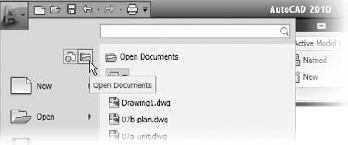

Click the Browse button. In the Select Drawing File dialog box, double-click the
07a-unitfilename (07a-unit-metricfor metric users).Click OK in the Insert dialog box. A warning message tells you that a block already exists with the same name as the file. You can cancel the operation or redefine the block in the current drawing.
Click Yes. The drawing regenerates (unless you have Regenauto turned off).
At the
Specify insertion point or [Basepoint/Scale/X/Y/Z/Rotate]:prompt, press the Esc key. You do this because you don't want to insert theUnitfile into your drawing; you're just using the Insert feature to update an existing block.Zoom in to one of the units. The floor tile appears in all the units as you drew it in the
Unitfile (see Figure 7.12).
Nested blocks must be updated independently of the parent block. For example, if you modified the Toilet block while editing the 07a-unit file and then updated the 07a-unit drawing in the 07b-plan file, the old Toilet block wouldn't be updated. Even though the toilet is part of the 07a-unit file, it's still a unique, independent block in the Plan file, and AutoCAD won't modify it unless specifically instructed to do so. In this situation, you must edit the original Toilet block and then update it in both the Plan and Unit files.
Also, block references and layer settings of the current file take priority over those of the imported file. For example, if a file to be imported has layers of the same name as the layers in the current file but those layers have color and linetype assignments that are different from the current file's, the current file's layer color and linetype assignments determine those of the imported file. This doesn't mean, however, that the imported file on disk is changed; only the inserted drawing is affected.
You may have noticed the Associative option in the Hatch And Gradient dialog box. When this radio button is selected, AutoCAD creates an associative hatch pattern. Associative hatches adjust their shapes to any changes in their associated boundary, hence the name. The following exercise demonstrates how this works.
Suppose you want to enlarge the tiled area of the kitchen by one tile. Here's how it's done:

Click the outline border of the hatch pattern you created earlier. Notice the grips that appear around the hatch-pattern area.
Shift+click the grip in the lower-left corner of the hatch area.
With the lower-left grip highlighted, Shift+click the lower-right grip.
Click the lower-right grip again, but don't Shift+click this time.
Enter @12<−90

Press the Esc key twice to clear any grip selections.
Choose Save from the Quick Access toolbar to save the Unit file.

The Associative feature of hatch patterns can save time when you need to modify your drawing, but you need to be aware of its limitations. A hatch pattern can lose its associativity when you do any of the following:
Erase or explode a hatch boundary
Erase or explode a block that forms part of the boundary
Move a hatch pattern away from its boundary
These situations frequently arise when you edit an unfamiliar drawing. Often, boundary objects are placed on a layer that is off or frozen, so the boundary objects aren't visible. Also, the hatch pattern might be on a layer that is turned off, and you proceed to edit the file not knowing that a hatch pattern exists. When you encounter such a file, take a moment to check for hatch boundaries so you can deal with them properly.
Like everything else in a project, a hatch pattern may eventually need to be changed in some way. Hatch patterns are like blocks in that they act like single objects. You can explode a hatch pattern to edit its individual lines. The Properties palette contains most of the settings you'll need to make changes to your hatch patterns. But the most direct way to edit a hatch pattern is to use the Hatch Edit dialog box.
Follow these steps to modify a hatch pattern by using the Hatch Edit dialog box:

Press the Esc key to clear any grip selections that may be active from earlier exercises.
Double-click the hatch pattern in the kitchen to open the Hatch Edit dialog box. It's the same as the Hatch And Gradient dialog box.
Click the Browse button to the right of the Pattern drop-down list to open the Hatch Pattern Palette dialog box at the Other Predefined tab (Figure 7.14).
Locate and double-click the pattern named AR-BRSTD. It's the pattern that looks like a brick wall. The Hatch Pattern Palette dialog box closes, and you see the AR-BRSTD hatch pattern in the Swatch field.
Click OK to accept the change to the hatch pattern. The AR-BRSTD pattern appears in place of the original parquet pattern.
Exit and save your file.
In this exercise, you were able to change the hatch just by double-clicking it. Although you changed only the pattern type, other options are available. You can, for example, modify a predefined pattern to a user-defined one by selecting User Defined from the Type listing in the Hatch Edit dialog box.
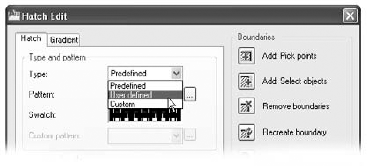
You can then enter angle and spacing values for your hatch pattern in the spaces provided in the Hatch Edit dialog box.
The other items in the Hatch Edit dialog box duplicate some of the options in the Hatch And Gradient dialog box. They let you modify the individual properties of the selected hatch pattern. The upcoming section, "Understanding the Boundary Hatch Options," describes these other properties in detail.
If you prefer, you can use the older method to edit a hatch pattern. To open the Properties palette, right-click a pattern and choose Properties from the shortcut menu. The Properties palette displays a Pattern category, which offers a Pattern Name option (Figure 7.15).
When you click this option, an ellipsis button appears, enabling you to open the Hatch Pattern Palette dialog box, just as in step 4 of the previous exercise. You can then select a new pattern from the dialog box. The Type option in the Properties palette lets you change the type of hatch pattern from Predefined to User Defined or Custom.
The Hatch And Gradient dialog box offers many other options that you didn't explore in the previous exercises. For example, instead of selecting the area to be hatched by clicking a point, you can select the objects that bound the area you want to hatch by clicking the Add: Select Objects button. You can use Add: Select Objects to add boundaries to existing hatch patterns as well.
The Swatch box just below the Pattern drop-down list opens the Hatch Pattern Palette dialog box, which lets you select a predefined hatch pattern from a graphic window.
The Hatch Pattern Palette dialog box has several tabs that further divide the types of hatch patterns into four categories: ANSI, ISO, Other Predefined, and Custom. The Custom tab is empty until you create your own set of custom hatch patterns. See Chapter 28 for details on how to create custom hatch patterns.
Other options in the right column of the Hatch And Gradient dialog box include Remove Boundaries, Recreate Boundary, View Selections, Annotative, Associative, Create Separate Hatches, Draw Order, and Inherit Properties:
- Remove Boundaries
Lets you remove a bounded area, or island, in the area to be hatched. An example is the toilet seat in the bathroom. This option is available only when you select a hatch area by using the Add: Pick Points option and an island has been detected.
- Recreate Boundary
Draws a region or polyline around the current hatch pattern. When this option is selected, the dialog box temporarily closes. You're then prompted to choose between a region or a polyline and to specify whether to reassociate the pattern with the re-created boundary. (See the Associative option discussed in a moment.)
- View Selections
Temporarily closes the dialog box and then highlights the objects that have been selected as the hatch boundary by AutoCAD.
- Annotative
Allows the hatch pattern to adjust to different scale views of your drawing. With this option turned on, a hatch pattern's size or spacing adjusts to the annotation scale of a viewport Layout or Model Space view. See Chapter 4 for more on the annotation scale.
- Associative
Allows the hatch pattern to adjust to changes in its boundary. With this option turned on, any changes to the associated boundary of a hatch pattern cause the hatch pattern to flow with the changes in the boundary.
- Create Separate Hatches
Creates separate and distinct hatches if you select several enclosed areas while selecting hatch areas. With this option off, separate hatch areas behave as a single hatch pattern.
- Draw Order
Allows you to specify whether the hatch pattern appears on top of or underneath its boundary. This is useful when the boundary is of a different color or shade and must read clearly or when the hatch pattern must cover the boundary.
- Inherit Properties
Lets you select a hatch pattern from an existing one in the drawing. This is helpful when you want to apply a hatch pattern that is already used but you don't know its name or its scale, rotation, or other properties.
AutoCAD's Boundary Hatch command has a fair amount of "intelligence." As you saw in an earlier exercise, it was able to detect not only the outline of the floor area, but also the outline of the toilet seat that represents an island in the pattern area. If you prefer, you can control how AutoCAD treats these island conditions and other situations by selecting options available when you click the More Options button in the lower-right corner of the Hatch And Gradient dialog box.
This button expands the dialog box to show additional hatch options (Figure 7.16).
The Islands group at the top of the dialog box controls how nested boundaries affect the hatch pattern. The graphics in this group show examples of the effect of the selected option. The Islands group includes the following options:
- Island Detection
Turns on the Island Detection feature. This check box excludes closed objects within the boundary from being hatched. For example, when you were hatching the bathroom in an earlier exercise, the toilet seat wasn't hatched because it was an island within the boundary.
- Normal
Causes the hatch pattern to alternate between nested boundaries. The outer boundary is hatched; if there is a closed object within the boundary, it isn't hatched. If another closed object is inside the first closed object, that object is hatched. This is the default setting.
- Outer
Applies the hatch pattern to an area defined by the outermost boundary and a closed object within that boundary. Any boundaries nested in that closed object are ignored.
- Ignore
Supplies the hatch pattern to the entire area within the outermost boundary, ignoring any nested boundaries.
The Boundary Hatch command can also create an outline of the hatch area by using one of two objects: 2D regions, which are like 2D planes, or polyline outlines. Boundary Hatch creates such a polyline boundary temporarily to establish the hatch area. These boundaries are automatically removed after the hatch pattern is inserted. If you want to retain the boundaries in the drawing, make sure the Retain Boundaries check box is selected. Retaining the boundary can be useful if you know you'll be hatching the area more than once or if you're hatching a fairly complex area.
Retaining a hatch boundary is useful if you want to know the hatched area's dimensions in square inches or feet because you can find the area of a closed polyline by using the List command. See Chapter 2 for more on the List command.
The Boundary Hatch feature is view dependent; that is, it locates boundaries based on what is visible in the current view. If the current view contains a lot of graphic data, AutoCAD can have difficulty finding a boundary or can be slow in finding a boundary. If you run into this problem, or if you want to single out a specific object for a point selection boundary, you can further limit the area that AutoCAD uses to locate hatch boundaries by using the Boundary Set options:
- New (Select New Boundary Set)
Lets you select the objects from which you want AutoCAD to determine the hatch boundary instead of searching the entire view. The screen clears and lets you select objects. This option discards previous boundary sets. It's useful for hatching areas in a drawing that contain many objects that you don't want to include in the hatch boundary.
- Current Viewport
Uses the current viewport extents to define the boundary set.
The Boundary Set options are designed to give you more control over the way a point selection boundary is created. These options have no effect when you use the Add: Select Objects button to select specific objects for the hatch boundary.
This group lets you hatch an area that isn't completely enclosed. The Gap Tolerance value sets the maximum gap size in an area you want to hatch. You can use a value from 0 to 5000.
You may have noticed that one of the hatch patterns offered is a solid. The solid hatch pattern lets you apply a solid color instead of a pattern to a bounded area. AutoCAD also offers a set of gradient patterns that let you apply a color gradient to an area.
You can apply a gradient to an area by using the same method you used to apply a hatch pattern, but instead of using the Hatch tab of the Hatch And Gradient dialog box, you use the Gradient tab to select a gradient pattern (Figure 7.17).
Instead of offering hatch patterns, the Gradient tab offers a variety of gradient patterns. It also lets you control the color of the gradient. For example, if you want to set the gradient between shades of blue, you can click the One Color radio button and then double-click the blue color swatch at the top of the dialog box.
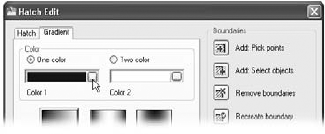
When you double-click the color swatch, the Select Color dialog box opens, offering a palette of True Color options (Figure 7.18).
You can then select the color you want for the gradient. On the Gradient tab of the Hatch And Gradient dialog box, the Shade/Tint slider just below the Two Color radio button lets you control the shade of the single-color gradient.
You can choose a gradient that transitions between shades of a single color by clicking the One Color radio button, or you can transition between two entirely different colors by clicking the Two Color radio button. When you select Two Color, the slider below the Two Color option changes to a color swatch. You can double-click the swatch or click the browse button to the right of the swatch to open the Select Color dialog box.
Just below the One Color and Two Color options are the gradient pattern options. You can choose from nine patterns, plus you can select an angle for the pattern from the Angle drop-down list box. The Centered option places the center of the gradient at the center of the area selected for the pattern.
To place a gradient pattern, select a set of objects or a point in a bounded area, just as you would for a hatch pattern. You can then click the Preview button to preview your hatch pattern, or you can click OK to apply the gradient to the drawing.
Here are a few tips on using the Boundary Hatch feature:
Watch out for boundary areas that are part of a large block. AutoCAD examines the entire block when defining boundaries. This can take time if the block is large. Use the Boundary Set options to focus in on the set of objects you want AutoCAD to use for your hatch boundary.
The Boundary Hatch feature is view dependent; that is, it locates boundaries based on what is visible in the current view. To ensure that AutoCAD finds every detail, zoom in to the area to be hatched.
If the area to be hatched is large yet requires fine detail, first outline the hatch area by using a polyline. (See Chapter 19 for more on polylines.) Then use the Add: Select Objects option in the Hatch And Gradient dialog box to select the polyline boundary manually instead of depending on Boundary Hatch to find the boundary for you.
Consider turning off layers that might interfere with AutoCAD's ability to find a boundary.
Boundary Hatch works on nested blocks as long as the nested block entities are parallel to the current UCS.
Suppose you're working on a plan in which you're constantly repositioning equipment and furniture or you're in the process of designing the floor covering. You might be a little hesitant to place a hatch pattern on the floor because you don't want to have to rehatch the area each time you move a piece of equipment or change the flooring. You have two options in this situation: You can use Boundary Hatch's associative capabilities to include the furnishings in the boundary set, or you can use the Display Order feature.
Associative Hatch is the most straightforward method. Make sure the Associative option is selected in the Hatch And Gradient dialog box, and include your equipment or furniture in the boundary set. You can do this by using the Add: Select Objects option in the dialog box.
After the pattern is in place, the hatch pattern automatically adjusts to its new location when you move the furnishings in your drawing. One drawback, however, is that AutoCAD attempts to hatch the interior of your furnishings if they cross the outer boundary of the hatch pattern. Also, if any boundary objects are erased or exploded, the hatch pattern no longer follows the location of your furnishings. To avoid these problems, you can use the method described in the next section.
The Draw Order feature lets you determine how objects overlap. In the space-planning example, you can create furniture by using a solid hatch to indicate horizontal surfaces (see Figure 7.19).
You can then place the furniture on top of a floor-covering pattern and the pattern will be covered and hidden by the furniture. Here's how to do that. (These steps aren't part of the regular exercises of this chapter. They're shown here as general guidelines when you need to use the Draw Order feature.)
Draw the equipment outline, and make sure the outline is a closed polygon.

In the Hatch And Gradient dialog box, make sure that Send Behind Boundary is selected in the Draw Order drop-down list.
Complete the rest of the hatch pattern.
After you've finished placing the hatch, turn the outline and solid hatch into a block, or use the Group command to group them.
Click the Bring To Front tool form the Draworder flyout on the Home tab's Modify panel, and then select the equipment.
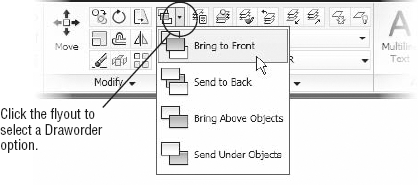
Press

After you take these steps, you can place the equipment over a hatched floor pattern, and the equipment will appear to rest on top of the pattern. If you create a floor pattern after you create the equipment, click the Send To Back option in the Draworder flyout to move the pattern to the back of the display order. You can also change the display order of objects relative to other objects.
The Draworder options are all part of the Draworder command. As an alternative to the menu, you can type Draworder
Enter object ordering option [Above objects/Under objects/Front/Back] <Back>:
For example, the equivalent of choosing the Send To Back tool from the Draworder flyout is entering Draworder
If you need to white out an area of a hatch pattern to make text more readable, you can use a solid hatch along with the Display Order option to block out areas behind text.
You've had a detailed look at hatch patterns and fills in this section. Remember that you can also use the Tool palettes to help organize and simplify access to your favorite hatch patterns, or you can use the patterns already available in the Tool palettes. The patterns in the Tool palettes can be edited and manipulated in the same way as described in this chapter. If you want to know how to make full use of the Tool palettes, check out the discussion on the AutoCAD DesignCenter in Chapter 29.
AutoCAD allows you to import drawings in a way that keeps the imported drawing independent from the current one. A drawing imported in this way is called an external reference (Xref). Unlike drawings that have been imported as blocks, Xref files don't become part of the drawing's database. Instead, they're loaded along with the current file at startup time. It's as if AutoCAD were opening several drawings at once: the currently active file you specify when you start AutoCAD and any file inserted as an Xref.
If you keep Xref files independent from the current file, any changes you make to the Xref automatically appear in the current file. You don't have to update the Xref file manually as you do blocks. For example, if you use Xref to insert the Unit file into the Plan file and you later make changes to the Unit file, you will see the new version of the Unit file in place of the old the next time you open the Plan file. If the Plan file was still open while edits were made, AutoCAD will notify you that a change had been made to an Xref.
Another advantage of Xref files is that because they don't become part of a drawing's database, drawing size is kept to a minimum. This results in more efficient use of your hard disk space.
Xref files, like blocks, can be edited only by using special tools. You can, however, use osnaps to snap to a location in an Xref file, or you can freeze or turn off the Xref file's insertion layer to make it invisible.
The next exercise shows how to use an Xref in place of an inserted block to construct the studio apartment building. You'll first create a new unit file by copying the old one. Then you'll bring a new feature, the External References palette, to the screen. Follow these steps to create the new file:

Choose Save As from the Application menu to save it under the name
Unitxref.dwg, and then close theUnitxref.dwgfile. This will make a copy of the07a-unit.dwgfile for the following steps. Or, if you prefer, you can use theUnitxref.dwgfile for the following steps.Return to the
07b-planfile, choose Save As, and save the file under the namePlanxref. The current file is nowPlanxref.dwg.Erase all the Unit plans (enter E


Click Yes To All.
Now you're ready to use the External References palette:

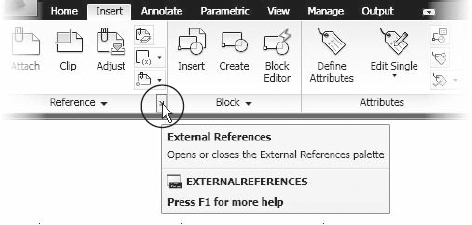
Click the Attach DWG button in the upper-left corner of the palette to open the Select Reference File dialog box. This is a typical AutoCAD file dialog box complete with a preview window.
Locate and select the
Unitxref.dwgfile, and then click Open to open the Attach External Reference dialog box (see Figure 7.21). Notice that this dialog box looks similar to the Insert dialog box. It offers the same options for insertion point, scale, and rotation.You'll see a description of the options presented in this dialog box. For now, click OK.
Enter 31′-5″,43′-8″

The inserted plan may appear faded. If it does, use the Xref Fading tool in the Insert tab's expanded Reference panel to give the plan a more solid appearance. Drag the Xref Fading tool to the left to do this.
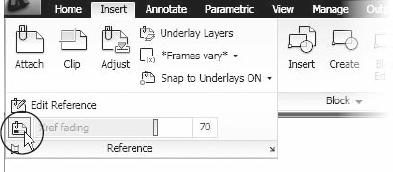
After the
Unitxref.dwgfile is inserted, re-create the same layout of the floor plan you created in the first section of this chapter by copying and mirroring theUnitxref.dwgexternal reference.Save the
Planxreffile.
You now have a drawing that looks like the 07b-plan.dwg file you worked with earlier in this chapter, but instead of blocks that are detached from their source file, you have a drawing composed of Xrefs. These Xrefs are the actual Unitxref.dwg file, and they're loaded into AutoCAD at the same time that you open the Planxref.dwg file. An icon in the lower-right corner of the AutoCAD window tells you that the current drawing contains Xrefs.
Next, you'll modify the Unitxref.dwg file and see the results in the Planxref.dwg file:
To open the
Unitxref.dwgfile, from the currentPlanxreffile, select and then right-click the unit and choose Open Xref from the shortcut menu. You can also enter Xopen
Erase the hatch pattern and kitchen outline for the floors, and save the
Unitxref.dwgfile.
Select the Unitxref name in the list box, click Reload, and then click OK. Notice that the units in the Planxref drawing have been updated to include the changes you made to the
Unitxreffile.
The Open option in the External References palette performs the same function as the Xopen command and the Open Xref option in the shortcut menu. To use this option, select and right-click the Xref files from the list box in the External References palette and then click Open.
Be aware that when an Xref has been modified, the Manage Xrefs icon at lower right in the AutoCAD window changes to show an exclamation point. This alerts you to changes in an Xref in the current drawing.
Click the Manage Xrefs icon to open the External References palette. The Xref that has been changed is indicated by a warning icon in the Status column of the list box.

You can then select the Xref that needs to be updated, right-click, and choose the Reload option from the shortcut menu to reload the selected Xref. You can also select multiple Xrefs if more than one needs updating.
Here you saw how an Xref file is updated in a different way than a block. Because Xrefs are loaded along with the drawing file that contains them, the containing file, which in this case was the Planxref file, automatically displays any changes made to the Xref when it's opened. Also, you avoid having to update nested blocks because AutoCAD updates nested Xrefs as well as non-nested Xrefs. When an Xref is modified while you're editing a file, you're alerted to the change through the Xref icon located in the lower-right corner of the AutoCAD window. You can click the balloon message that appears from that icon to update any modified Xrefs.
Here are a few other differences between Xrefs and inserted blocks that you'll want to keep in mind:
Any new layers, text styles, or linetypes brought in with cross-referenced files don't become part of the current file. If you want to import any of these items, you can use the Xbind command (described in Chapter 15).
If you make changes to the layers of a cross-referenced file, those changes aren't retained when the file is saved unless you checked the Retain Changes To Xref Layers option in the Open And Save tab of the Options dialog box. This option, found in the External References (Xrefs) group, instructs AutoCAD to remember any layer color or visibility settings from one editing session to the next. In the standard AutoCAD settings, this option is on by default.
Another way to ensure that layer settings for Xrefs are retained is to enter Visretain

To segregate layers in Xref files from layers in the current drawing, the names of the Xref file's layers are prefixed with their file's name. A vertical bar separates the filename prefix and the layer name when you view a list of layers in the Layer drop-down list or the Layer Properties Manager dialog box (as in Unitxref | wall).
You can't explode Xrefs. You can, however, convert an Xref into a block and then explode it. To do this, select the Xref in the External References palette to open another dialog box that offers two ways of converting an Xref into a block. See the section "Other External Reference Options" later in this chapter for more information.
If an Xref is renamed or moved to another location on your hard disk, AutoCAD won't be able to find that file when it opens other files to which the Xref is attached. If this happens, you must select the path in the Found At field in the External References palette and then click the Browse button (the ellipsis) to tell AutoCAD where to find the cross-referenced file.
Take care when retargeting an Xref file with the Browse button. The Browse button can assign a file of a different name to an existing Xref as a substitution.
Xref files are especially useful in workgroup environments in which several people are working on the same project. For example, one person might be updating several files that are inserted into a variety of other files. If blocks are used, everyone in the workgroup would have to be notified of the changes and would have to update all the affected blocks in all the drawings that contained them. With cross-referenced files, however, the updating is automatic; you avoid confusion about which files need their blocks updated.
Many other features are unique to external reference files. Let's briefly look at some of the other options in the External References palette.
Several options are available when you right-click an external reference name listed in the External References palette, shown in Figure 7.20 earlier in this chapter. You saw the Reload option in an earlier exercise. The following other options are available:
- Attach
Opens the Select Reference dialog box, in which you can select a file to attach and set the parameters for the attachment.
- Detach
Detaches an Xref from the current file. The file is then completely disassociated from the current file.
- Reload
Restores an unloaded Xref.
- Unload
Similar to Detach, but maintains a link to the Xref file so that it can be quickly reattached. This has an effect similar to freezing a layer and can reduce redraw, regeneration, and file-loading times.
- Bind
Converts an Xref into a block. Bind offers two options: Bind and Insert. Bind's Bind option maintains the Xref's named elements (layers, linetypes, and text and dimension styles) by creating new layers in the current file with the Xref's filename prefix (see Chapter 15). The Insert option doesn't attempt to maintain the Xref's named elements but merges them with named elements of the same name in the current file. For example, if both the Xref and the current file have layers of the same name, the objects in the Xref are placed in the layers of the same name in the current file.
- Open

Lets you open an Xref. Select the Xref from the list, and then click Open. The Xref opens in a new window when you close the External References palette. This option isn't available in AutoCAD LT.
- Details
A panel at the bottom of the External References palette. It's similar to the Properties palette in that it displays the properties of a selected external reference and also allows you to modify some of those properties. For example, the Reference Name option in the Details panel lets you give the external reference a name that is different from the Xref filename. Table 7.1 gives you a rundown of the options in the Details panel.
Table 7.1. The Details Panel of the External References Palette
Option | Function |
|---|---|
Reference Name | Lets you give the Xref a name that is different from the Xref's filename. This can be helpful if you want to use multiple external references of the same file. |
Status | Tells you whether the Xref is loaded, unloaded, or not found (read only). |
Size | Gives you the file size information (read only). |
Lets you choose between the Attach and Overlay attachment methods for the Xref file. Xrefs attached as overlays don't include nested Xrefs. | |
Date | Gives you the date and time the file was attached (read only). |
Saved Path | Tells you where AutoCAD expects to find the Xref file (read only). |
Found At | Lets you select the location of the Xref file. When you click the text box for this option, a Browse button appears to the right. You can click this button to locate a lost Xref or use a different file from the original attached Xref. |
The Attach External Reference dialog box, shown in Figure 7.21 earlier in this chapter, offers these options:
- Browse
Opens the Select Reference File dialog box to enable you to change the file you're importing as an Xref.
- Attachment
Tells AutoCAD to include other Xref attachments that are nested in the selected file.
- Overlay
Tells AutoCAD to ignore other Xref attachments that are nested in the selected file. This avoids multiple attachments of other files and eliminates the possibility of circular references (referencing the current file into itself through another file).
- Path Type
Offers options for locating Xrefs. Xref files can be located anywhere on your system, including network servers. For this reason, you can easily lose links to Xrefs either by moving them or by rearranging file locations. To help you manage Xrefs, the Path Type option offers three options: Full Path, Relative Path, and No Path. Full Path retains the current full path. Relative Path maintains paths in relation to the current drawing. The current drawing must be saved before using the Relative Path option. The No Path option is for drawings in which Xrefs are located in the same folder as the current drawing or in the path specified in Support File Search Path in the Files tab of the Options dialog box (choose Options from the Application menu).
- Specify On-Screen
Appears in three places. It gives you the option to enter insertion point, scale factors, and rotation angles in the dialog box or in the Command window, in a way similar to inserting blocks. If you clear this option for any of the corresponding parameters, the parameters change to allow input. If they're selected, you're prompted for those parameters after you click OK to close the dialog box. With all three Specify On-Screen check boxes cleared, the Xref is inserted in the drawing using the settings indicated in the dialog box.
Xrefs are frequently used to import large drawings for reference or backgrounds. Multiple Xrefs, such as a floor plan, column grid layout, and site-plan drawing, might be combined into one file. One drawback to multiple Xrefs in earlier versions of AutoCAD was that the entire Xref was loaded into memory even if only a small portion of it was used for the final plotted output. For computers with limited resources, multiple Xrefs could slow the system to a crawl.
AutoCAD 2010 offers two tools that help make display and memory use more efficient when using Xrefs: the Xclip command and the Demand Load option in the Options dialog box.
You can clip blocks and multiple Xrefs as well. You can also specify a front and back clipping distance so that the visibility of objects in 3D space can be controlled. You can define a clip area by using polylines or spline curves, although curve-fitted polylines revert to decurved polylines. (See Chapter 19 for more on polylines and spline curves.)
The External References (Xrefs) group in the Open And Save tab of the Options dialog box offers some tools to help you manage memory use and other features related to Xrefs. If you're working on large projects with others in a workgroup, you should be aware of these settings and what they do.
The Demand Load Xrefs drop-down list offers three settings: Disabled, Enabled, and Enabled With Copy. Demand Load is set to Enable With Copy by default in the standard AutoCAD drawing setup. In addition to reducing the amount of memory an Xref consumes, Demand Load prevents other users from editing the Xref while it's being viewed as part of your current drawing. This helps aid drawing version control and drawing management. The Enabled With Copy option creates a copy of the source Xref file and then uses the copy, thereby enabling other AutoCAD users to edit the source Xref file.
Demand loading improves performance by loading only the parts of the referenced drawing that are needed to regenerate the current drawing. You can set the location for the Xref copy in the Files tab of the Options dialog box under Temporary External Reference File Location.
Two other options are also available in the Options dialog box:
- Retain Changes To Xref Layers
Instructs AutoCAD to remember any layer color or visibility settings of Xrefs from one editing session to the next. In the standard AutoCAD settings, this option is on by default.
- Allow Other Users To Refedit Current Drawing
Lets others edit the current drawing by choosing Edit Reference from the Insert tab's expanded Reference panel (Refedit). You'll learn about this command in the next section.
You've seen different methods for editing blocks and Xrefs as external files. There is another way to edit a block or an Xref directly in a file, without having to edit an external file: You can use the Xref And Block In-Place Editing option in the Tools drop-down menu. This option issues the Refedit command.
The following exercise demonstrates how Refedit works:
If it isn't already open, open the
Planxref.dwgfile. Also make sure you've closed theUnitxref.dwgfile.Zoom in to the unit plan in the lower-left corner of the drawing so you see a view similar to Figure 7.23.
Click the corner unit to select it. Notice that the External Reference tab appears, offering several options that allow you to edit the Xref. You'll learn more about these options later.
Double-click the wall of the corner unit. The Reference Edit dialog box appears (Figure 7.24).
The Reference Edit dialog box contains two panels. The right panel shows a thumbnail view of the item that you're editing. The left panel shows a listing of the specific item you selected in the Xref. Notice that the listing shows the hierarchical relationship of the kitchenette block in relation to the Unitxref Xref.
In the left panel, click the unitxref|KITCHEN listing and then click OK. The Edit Reference panel appears in the current Ribbon tab.
Use a selection window to select the entire lower-left corner unit. Notice that only the grips in the kitchenette appear, indicating that the objects in the kitchenette are selected. Although the rest of the unit appears to be selected, it appears lighter in color. This shows you that only the kitchen is available for editing.
Press the Esc key to clear your selection.
In step 5 of the previous exercise, the Refedit command isolates the objects you select for editing. You can't edit anything else in the Xref until you exit the Refedit command and start over.
At this point, you can edit a block in an Xref. Now let's continue editing the kitchenette:
Zoom in on the kitchenette, and move the four burners to the right 8″ (20 cm for metric users).
Erase the sink.

A warning message appears, telling you that the changes you've made to the Xref will be saved. Click OK.
Zoom back to your previous view. Notice that the other units reflect the changes you made to the Unitxref Xref (see Figure 7.25).
Open the
Unitxref.dwgfile. The kitchen reflects the changes you made to the Xref of the unit in thePlanxreffile. This shows you that by choosing to save the reference edit in step 3, you save the changes back to the Xref's source file.
As you saw from these two exercises, it's possible to edit a specific block in an Xref, but to do that you must select the block name in the Reference Edit dialog box.
In these exercises, you edited a block contained in an Xref, but you could have just as easily edited a block in the current drawing. You can also edit nested blocks by using the Refedit command. Changes in blocks in the current file don't affect other files because blocks aren't linked to external files. The changes to blocks remain in the current file until you explicitly export the changed block to a file, as you saw in earlier exercises.
Earlier, you saw that when you click an Xref, the External Reference tab appears. This tab offers several tools divided into three panels: Edit, Clipping, and Options. See Table 7.2 for a complete description of these tools.
Table 7.2. The External Reference Tab Options
Tool Name | Function |
|---|---|
Edit Reference In-Place | Starts the Refedit command, which allows you to edit an Xref within the current drawing. |
Open Reference | Opens the selected Xref. |
Create Clipping Boundary | Starts the Xclip command, which allows you to hide portions of an Xref. This feature is similar to the Image clipping command described in Chapter 14. |
Removing Clipping | Removes a clipping boundary. |
External Reference | Opens the External Reference palette. |
In the previous exercises, you removed objects from the Kitchen block by using the Erase command. You can also move objects from a block or an Xref into the current drawing without erasing them. To do this, choose Remove From Working Set from the Insert tab's expanded Edit Reference panel while in the Refedit command. This removes the objects from the block or Xref without erasing them. Likewise, you can add new objects to the block or Xref by choosing Add To Working Set from the Insert tab's expanded Edit Reference panel. Both menu options invoke the Refset command, with different options applied.
To see how Refset works, try the following exercise:
Close the
Unitxref.dwgfile.In the
Planxreffile, zoom in to the kitchenette to get a view similar to the top panel of Figure 7.26.Double-click the unit plan drawing. You can also choose Edit Reference from the Insert tab's expanded Reference panel and then click the unit plan.
Click the unitxref|KITCHEN listing in the Reference Edit dialog box, and then click OK.
Use the Move tool to move the two burners on the right just to the right of the kitchenette, as shown in Figure 7.26.

Select the two burners you just moved, and then press

Notice that the burners become grayer to show that they're removed from the working set. They remain as part of the Planxref drawing, but they're no longer part of the Kitchen block.
Now add a rectangle to the Kitchen block in place of the burners:
Draw a 7″ × 16″ (18 cm × 40 cm) rectangle in place of the moved burners, as shown in the top panel of Figure 7.26. Anything you add to the drawing automatically becomes part of the working set.

Zoom out enough to see the other units in the drawing (see Figure 7.27).
You can see that the burners have been replaced by the rectangle in all the other Xref units. The burners you moved are still there in the lower-left corner unit, but they have been removed from all the Xrefs. It's as if you extracted them from the block and placed them in the Plan drawing.
While you were using the Refedit command, any new objects you create are added to the working set automatically. When you drew the rectangle in step 1, for example, it was automatically included in the working set, which is the set of objects included in the block or Xref you're currently working on. You didn't have to specifically add it to the working set.
You've completed the exercises in this chapter, so you can exit AutoCAD without saving these changes.
The Reference Edit dialog box offers you the option to isolate specific blocks in the Xref by selecting them from the hierarchy list. You may have noticed the two radio button options: Automatically Select All Nested Objects and Prompt To Select Nested Objects. The default option, Automatically Select All Nested Objects, lets you select any object contained in the selected object in the hierarchy listing. If you select the Prompt To Select Nested Objects option, you're prompted to select objects on the screen before the Edit Reference panel appears.
In addition to the options you used in the exercises, the Reference Edit dialog box also includes the Settings tab with some options (Figure 7.28).
When you use the Refedit command with the Automatically Select All Nested Objects option turned on, you can import nested blocks into the current drawing. For example, if you selected the Bath block in the hierarchy list in the previous exercise, you would have access to the Tub and Toilet blocks in the Bath block. You could then copy either of those blocks into the current file.
When you make a copy of a block from an Xref, AutoCAD needs to assign that block a name. The Create Unique Layer, Style, And Block Names option tells AutoCAD to use the original block name and append a $#$ prefix to the name (# is a numeric value starting with zero). If you were to import the Bath block, for example, it would become $0$bath in the current drawing. This ensures that the block maintains a unique name when it's imported even if there is a block with the same name in the current drawing. If you turn off the Create Unique Layer, Style, And Block Names option, the original name is maintained. If the current drawing contains a block of the same name, the imported block uses the current file's definition of that block.
If your drawing contains attributes (see Chapter 13 for more on attributes), this option is offered. If you turn on this option, you can then edit attribute definitions by using the Refedit command. If you select a block that contains an attribute definition while you're using the Refedit command, the attribute definition is exposed, enabling you to make changes. Changes to attribute definitions affect only new attribute insertions. Except for the attribute of the edited block, existing attributes aren't affected. If you want to update existing attributes to a newly edited definition, use the Sync option of the Block Attribute Manager (choose Manage Attributes from the Home tab's expanded Block panel).
- Assemble the parts
Technical drawings are often made up of repetitive parts that are drawn over and over. AutoCAD makes quick work of repetitive elements in a drawing, as shown in the first part of this chapter.
- Master It
What is the object used as the basic building block for the unit plan drawing in the beginning of this chapter?
- Take control of the AutoCAD display
Understanding the way the AutoCAD display works can save you time, especially in a complex drawing.
- Master It
Name the dialog box used to save views in AutoCAD. Describe how to recall a saved view.
- Use hatch patterns in your drawings
Patterns can convey a lot of information at a glance. You can show the material of an object, or you can indicate a type of view, like a cross section, by applying hatch patterns.
- Master It
How do you open the Hatch And Gradient dialog box?
- Understand the boundary hatch options
The boundary hatch options give you control over the way hatch patterns fill an enclosed area.
- Master It
Describe an island as it relates to boundary hatch patterns.
- Use external references
External references are drawing files that you've attached to the current drawing to include as part of the drawing. Because external references aren't part of the current file, they can be worked on at the same time as the referencing file.
- Master It
Describe how drawing files are attached as external references.



